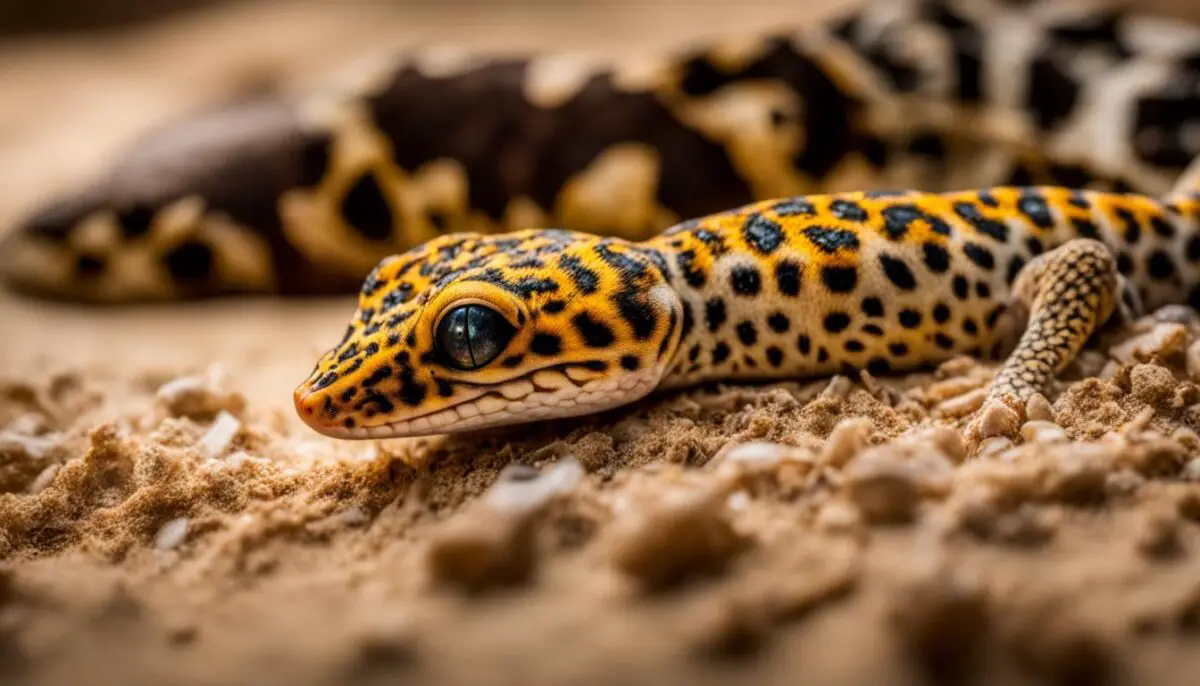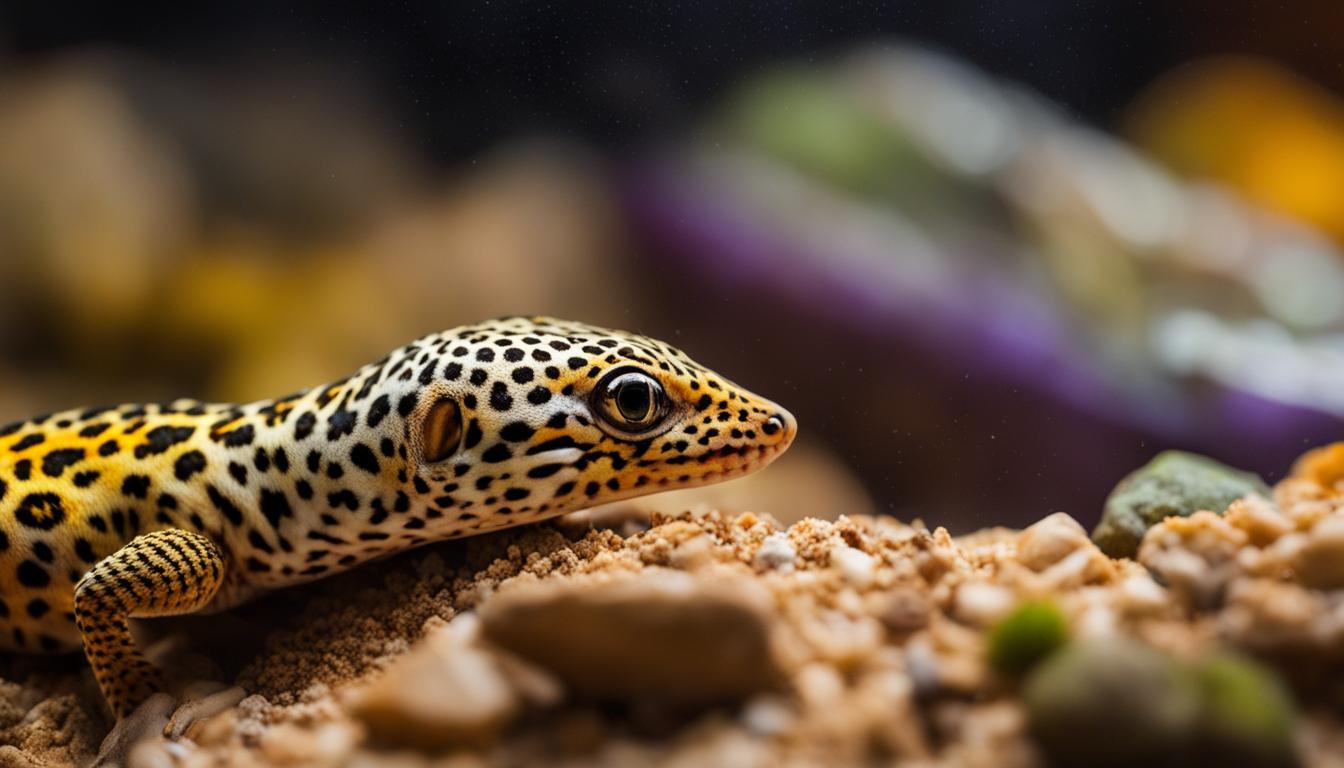Leopard geckos, like all reptiles, shed their skin periodically to allow for growth. This natural process can cause excitement and concern among leopard gecko owners. If you’re curious about whether leopard geckos eat their shed skin and what it means for their diet, you’ve come to the right place.
Key Takeaways:
- Leopard geckos shed their skin to accommodate growth.
- Observing changes in color and behavior can indicate shedding in leopard geckos.
- The shedding frequency varies depending on the gecko’s age and growth rate.
- There is no specific shedding season for leopard geckos.
- Leopard geckos eat their shed skin for energy, nutrients, and hygiene.
How Do I Know If My Leo Is Shedding?
One noticeable sign that a leopard gecko is shedding is a change in color. As the shedding process begins, the gecko’s coloration may become duller and eventually turn grayish-white. Additionally, leopard geckos may exhibit changes in behavior, such as spending more time in their moist hide or showing a decreased appetite. The shedding process typically begins with the flaking of skin on the head and progresses to the rest of the body.

It’s essential for leopard gecko owners to be aware of their pet’s shedding behavior to ensure their well-being and provide the necessary care. Monitoring their color changes and observing any shifts in behavior can help determine if they are going through the shedding process.
How Often Do Leopard Geckos Shed?
The shedding frequency of leopard geckos can vary depending on their age and growth rate. Young geckos that are still growing may shed more frequently than adult geckos. It is not uncommon for young geckos to shed every week or even bi-weekly as their bodies go through rapid growth and development. This frequent shedding helps them accommodate their changing size and keep their skin healthy.
As leopard geckos mature, shedding becomes less frequent. On average, adult geckos shed about once a month. However, it is important to note that there can be longer pauses between sheds in adult geckos. Factors such as temperature, humidity levels, and overall health can also affect the frequency of shedding.
It is important for leopard gecko owners to monitor their pets’ shedding habits and provide appropriate care during the shedding process. Creating a suitable environment with proper temperature and humidity levels can help facilitate the shedding process and ensure that the gecko sheds its skin smoothly.
Now, let’s take a closer look at the shedding habits of leopard geckos:
| Age | Shedding Frequency |
|---|---|
| Young geckos | Frequently, up to once a week or bi-weekly |
| Adult geckos | About once a month on average |
Achart summarizing the shedding frequency in leopard geckos at different ages.

Understanding the shedding habits of leopard geckos can help owners provide appropriate care and ensure the well-being of their pets. It is important to note that shedding is a natural and necessary process for leopard geckos, and regular shedding indicates a healthy gecko.
Is There A Shedding Season For Leopard Geckos?
Leopard geckos may shed their skin at any time, without a specific shedding season. Unlike certain reptiles that display seasonal shedding patterns, leopard geckos shed according to their individual needs and conditions. However, shedding behavior may be influenced by factors such as brumation and gravidity.
Brumation and Shedding
Brumation is a period of dormancy that some reptiles, including leopard geckos, undergo during colder months. While brumating, leopard geckos may exhibit reduced activity, appetite, and shedding frequency. This state of dormancy is similar to hibernation and can affect the gecko’s shedding cycle, making shedding less likely during the brumation period.
Gravidity and Shedding
When a female leopard gecko is gravid, meaning she is carrying eggs, she may also show a decrease in shedding behavior. Gravid geckos have different priorities, focusing on nesting and laying eggs rather than shedding their skin. Therefore, it is less common for a gravid leopard gecko to shed during this period.
While brumation and gravidity can affect shedding behavior, it’s important to note that individual leopard geckos may still shed during these periods. Each gecko is unique, and their shedding patterns can vary. Therefore, it is essential to observe the specific behavior of your leopard gecko to understand its shedding needs.
Understanding the influence of brumation and gravidity on leopard gecko shedding can help you better care for your gecko during these periods. By providing a suitable environment and monitoring their behavior, you can ensure their shedding process remains healthy and stress-free.
Why Do Leopard Geckos Eat Their Shed?
Leopard geckos have some fascinating eating habits, and one of them is consuming their shed skin. But why do they do that? There are several reasons behind this behavior that are beneficial to these unique reptiles.
First and foremost, eating the shed skin allows leopard geckos to replenish their energy and essential nutrients quickly. Rather than hunting for prey, they can conveniently consume their shed skin to regain strength.
In the wild, this behavior also serves as a survival mechanism. By consuming their shed skin, leopard geckos help camouflage their presence from potential predators. This natural instinct aids in their protection, as predators may be less likely to detect them through the scent of their shed skin.
Furthermore, leopard geckos are naturally clean animals. By eating their shed skin, they help to maintain hygiene in their enclosure. Removing the old skin prevents the accumulation of waste and potential contamination, promoting a healthier environment for these reptiles.
It is essential to offer shed skin safely to leopard geckos. Ensure that the shed skin is clean and free from contaminants before providing it as a food source. By understanding and appreciating this unique behavior, leopard gecko owners can further support the well-being of their beloved pets.
FAQ
Do leopard geckos eat their shed?
Yes, leopard geckos eat their shed skin. It helps them regain energy and essential nutrients, camouflages their presence from predators in the wild, and maintains hygiene in their enclosure.
How do I know if my Leo is shedding?
One noticeable sign is a change in color, with the gecko’s coloration becoming duller and eventually turning grayish-white. Leopard geckos may also exhibit changes in behavior, such as spending more time in their moist hide or showing a decreased appetite.
How often do leopard geckos shed?
The shedding frequency varies depending on the age and growth rate of the gecko. Young geckos shed more frequently, sometimes every week or bi-weekly. As they mature, shedding becomes less frequent, occurring about once a month on average.
Is there a shedding season for leopard geckos?
Generally, there is no specific season for shedding in leopard geckos. However, adult geckos are less likely to shed while brumating (a period of dormancy) or when gravid (carrying eggs). Shedding can occur at any time depending on the individual gecko’s needs and conditions.
Why do leopard geckos eat their shed?
Leopard geckos eat their shed skin to quickly regain energy and essential nutrients without hunting for prey. In the wild, eating shed skin helps camouflage their presence from predators. Additionally, they are naturally clean animals, and removing their shed skin helps maintain hygiene in their enclosure.


